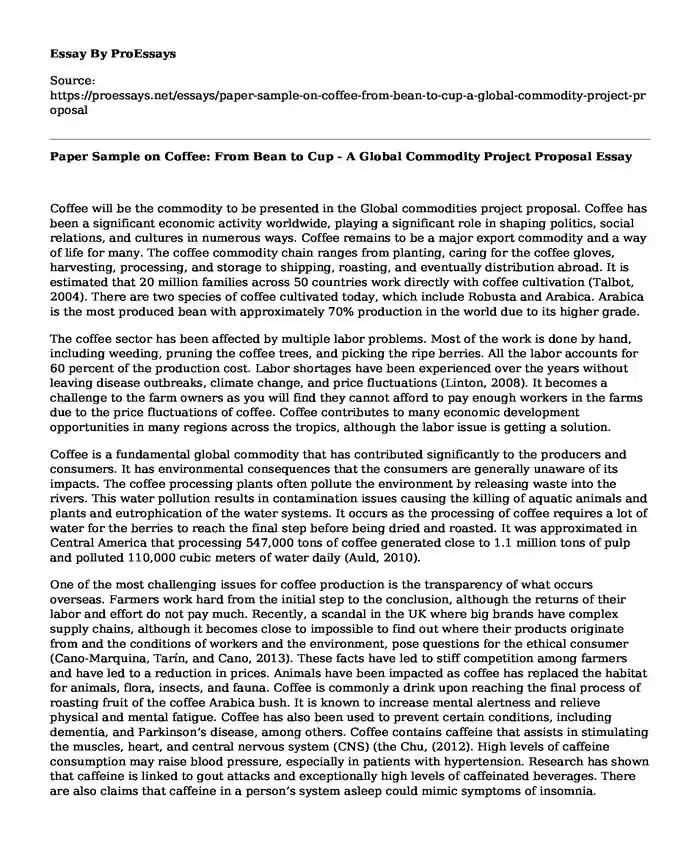Coffee will be the commodity to be presented in the Global commodities project proposal. Coffee has been a significant economic activity worldwide, playing a significant role in shaping politics, social relations, and cultures in numerous ways. Coffee remains to be a major export commodity and a way of life for many. The coffee commodity chain ranges from planting, caring for the coffee gloves, harvesting, processing, and storage to shipping, roasting, and eventually distribution abroad. It is estimated that 20 million families across 50 countries work directly with coffee cultivation (Talbot, 2004). There are two species of coffee cultivated today, which include Robusta and Arabica. Arabica is the most produced bean with approximately 70% production in the world due to its higher grade.
The coffee sector has been affected by multiple labor problems. Most of the work is done by hand, including weeding, pruning the coffee trees, and picking the ripe berries. All the labor accounts for 60 percent of the production cost. Labor shortages have been experienced over the years without leaving disease outbreaks, climate change, and price fluctuations (Linton, 2008). It becomes a challenge to the farm owners as you will find they cannot afford to pay enough workers in the farms due to the price fluctuations of coffee. Coffee contributes to many economic development opportunities in many regions across the tropics, although the labor issue is getting a solution.
Coffee is a fundamental global commodity that has contributed significantly to the producers and consumers. It has environmental consequences that the consumers are generally unaware of its impacts. The coffee processing plants often pollute the environment by releasing waste into the rivers. This water pollution results in contamination issues causing the killing of aquatic animals and plants and eutrophication of the water systems. It occurs as the processing of coffee requires a lot of water for the berries to reach the final step before being dried and roasted. It was approximated in Central America that processing 547,000 tons of coffee generated close to 1.1 million tons of pulp and polluted 110,000 cubic meters of water daily (Auld, 2010).
One of the most challenging issues for coffee production is the transparency of what occurs overseas. Farmers work hard from the initial step to the conclusion, although the returns of their labor and effort do not pay much. Recently, a scandal in the UK where big brands have complex supply chains, although it becomes close to impossible to find out where their products originate from and the conditions of workers and the environment, pose questions for the ethical consumer (Cano-Marquina, Tarín, and Cano, 2013). These facts have led to stiff competition among farmers and have led to a reduction in prices. Animals have been impacted as coffee has replaced the habitat for animals, flora, insects, and fauna. Coffee is commonly a drink upon reaching the final process of roasting fruit of the coffee Arabica bush. It is known to increase mental alertness and relieve physical and mental fatigue. Coffee has also been used to prevent certain conditions, including dementia, and Parkinson’s disease, among others. Coffee contains caffeine that assists in stimulating the muscles, heart, and central nervous system (CNS) (the Chu, (2012). High levels of caffeine consumption may raise blood pressure, especially in patients with hypertension. Research has shown that caffeine is linked to gout attacks and exceptionally high levels of caffeinated beverages. There are also claims that caffeine in a person’s system asleep could mimic symptoms of insomnia.
References
Auld, G. (2010). Assessing certification as governance: effects and broader consequences for coffee. The Journal of Environment & Development, 19(2), 215-241.
Cano-Marquina, A., Tarín, J. J., & Cano, A. (2013). The impact of coffee on health. Maturitas, 75(1), 7-21.
The Chu, Y. F. (Ed.). (, 2012). Coffee: emerging health effects and disease prevention (Vol. 59). John Wiley & Sons.
Linton, A. (2008). A niche for sustainability? Fair labor and environmentally sound practices in the specialty coffee industry. Globalizations, 5(2), 231-245.
Talbot, J. M. (2004). Grounds for Agreement: The political economy of the coffee commodity chain. Rowman & Littlefield Publishers.
Cite this page
Paper Sample on Coffee: From Bean to Cup - A Global Commodity Project Proposal. (2023, Dec 29). Retrieved from https://proessays.net/essays/paper-sample-on-coffee-from-bean-to-cup-a-global-commodity-project-proposal
If you are the original author of this essay and no longer wish to have it published on the ProEssays website, please click below to request its removal:
- Nutrient and Physical Activity Analysis Project
- Dietary Recommendations for Hypertension Paper Example
- Healthy Eating for the Older Population Paper Example
- A Comprehensive Summary of My Dietary Intake: Tracking Progress Paper Example
- Essay Sample on Poor Eating Habits and Link to Lifestyle Diseases, Including Obesity
- Essay on My Western Diet: Few Fruits, High in Sugar and Refined Grains
- Red Meat, Fish, & Processed Foods: What Resolutions Should You Make? - Report Sample







